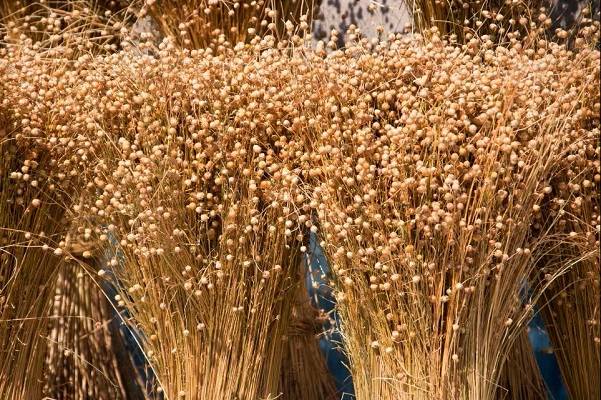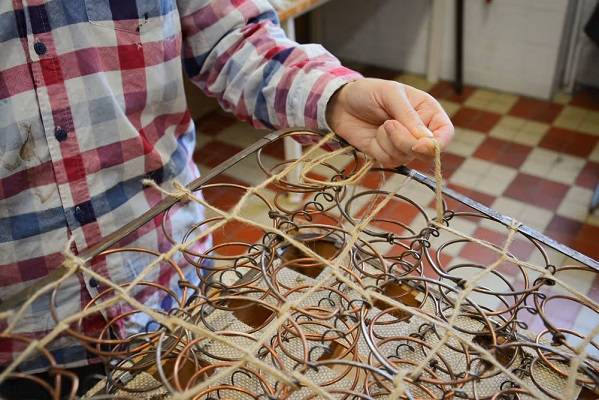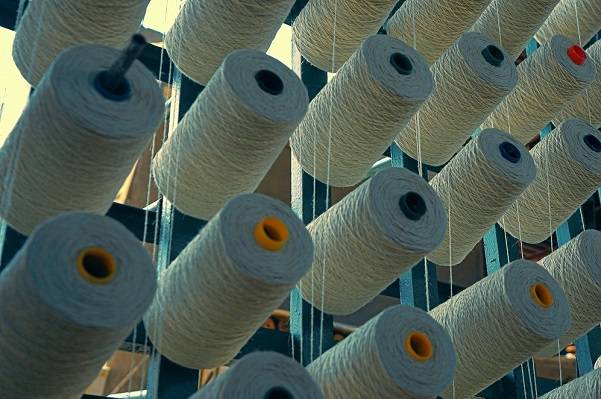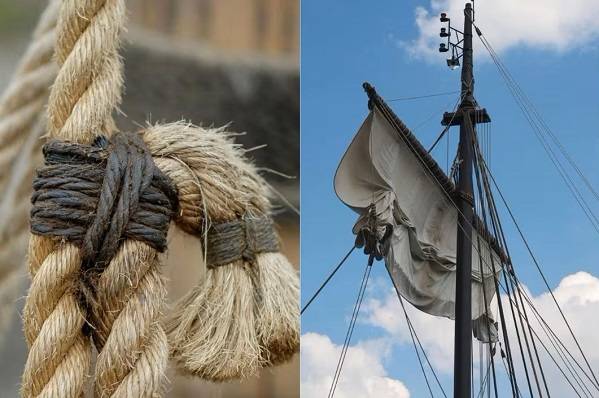LINEN WAXED THREAD 101
Guide To Linen Thread: Your Go-To Supply for Leather Sewing, Upholstery Projects & Crafts
Learn More About The Amazing Properties Of Flax Linen Thread & Why You Should Use It For Your DIY Projects

Innovation & Quality
Developing and supplying premium-quality, sustainably grown, consumer products
100% Natural
Organically Grown and Ethically Sourced
hemp and other natural fiber products
Shipping
We offer fast shipping
Your order out within 1-3 days
Wholesale
Visit our wholesale portal to register or login to your account
Throughout history, linen thread, made from enduring, cellulose fibers of the flax plant, has been considered a gold standard in the world of natural fibers. It stands out as one of the most prized supplies due to its remarkable properties - exceptional strength, durability, heirloom quality, water-resistance, and eco-friendliness. In this article, we will reveal everything you need to know about linen thread, including its origins, unique attributes, and present-day applications in sewing, leather crafts, upholstering, bobbin lace making, bookbinding, conservation, beading, jewelry making, embroidery, etc. We will also talk about waxed and non-waxed linen thread while offering advice on how to choose the right one for your DIY project. In addition, we will provide information on how to care for and maintain your handicrafts.
Table Of Contents:
Exploring versatile applications
Major benefits of flax linen thread
How to choose the ideal thread for your project
The comparison of waxed & non-waxed linen thread
The art of leather sewing: Accomplishing the desired look with waxed linen thread
Craft Sewing With Love: Shop Linen Thread at Hemptique
Hemptique specializes in manufacturing premium arts & crafts supplies for anyone looking for 100% natural and environmentally friendly materials. Browse our web shop to find the finest quality selection of supplies sourced from premium Egyptian flax: linen thread, linen twine, linen cord, linen spring twine, and tarred marline linen twine. Hemptique Premium linen thread is renowned for its outstanding properties such as strength, durability, longevity, moisture resistance, and eco-friendliness. This 3ply thread is made of 100% flax fiber. It is lightly waxed and comes in several different thicknesses, making it ideal for various projects, such as leather stitching, hand sewing and upholstery repair. Our merchandise is intended for individual consumers, businesses, wholesalers, schools, workshops, organizations, and anyone else who is looking to work with Earth-friendly materials. Call us at (760) 602-4864, ext. 402 & 405, or fill out a form to register for a wholesale account and enjoy the benefits of discounted prices.
Linen Thread Origins
Linen is one of the oldest fibers known to mankind. It has been widely used and valued for thousands of years, tracing back to ancient Egypt, about 10,000 years ago. Over the years linen was used for making clothing, bedding, household textiles, shoes, bandages, burial shrouds, and other things that helped humankind survive and lead easier life.
Exploring The Versatile Applications of Linen Thread
Renowned for its strong but flexible attributes, linen thread is suitable for a wide variety of uses, including:
Leather Stitching
Due to its high tensile strength and capability of creating durable and visually pleasing stitches, linen thread is a preferred supply for all kinds of leathercraft. Flax thread matches the natural look of leather, which is why it is a perfect choice for making leather goods such as keychains, bags, belts, horse saddles, purses, backpacks, pet collars, card wallets, etc.
Hand sewing
Since it is naturally resistant to friction, linen thread is excellent for hand-sewing projects where strength and tidiness are required. If you are making a garment or a costume, it will create a nice and sturdy seam that will prolong the life of your handmade product.
Bookbinding
Extra hold, minimal stretching, and decay resistance make flax string a favorite choice for bookbinding, particularly for binding archival-quality books, since they have to remain intact for future generations to use and enjoy. Flax fiber thread will not shift or loosen over time which means that it will withstand frequent handling and use.
Upholstery
Linen's unmatched strength and durability is highly beneficial in upholstery projects, where threads have to withstand constant wear and tension. With a long life cycle and extraordinary resistance to decay, it is a go-to choice for just about any upholstering work.

Major Benefits Of Flax Linen Thread
Using linen thread for your hobbies or work has plenty of advantages. This environmentally-friendly string of remarkable attributes is famous for several major benefits including:
- Durability: By being exceptionally strong, it easily resists snapping and fraying, which is a vital benefit when used for making items that will be used in high-tension settings, such as upholstery or horse saddle making.
- Antibacterial qualities: Antibacterial by nature, linen thread is ideal for sewing pieces that require cleanliness, such as clothing and bedding.
- Earth-friendliness: With its biodegradable and recyclable characteristics, it is an eco-responsible pick for those who are looking to minimize their carbon footprint.
- Moisture absorbing properties: Moisture absorbing properties provide comfort, while preventing sweat accumulation. This quality is especially favorable in garment or household textile making.
How To Choose The Ideal Thread For Your Project
When it comes to selecting the right linen thread, there are several factors you should take into account:
- Thread size and strength: Start by determining how strong and thick a thread should be to meet the requirements of your project. In general, thicker threads (larger diameter) are suitable for upholstery and leather work, while thinner ones are ideal for delicate sewing projects, such as tatting, lacing, or jewelry making.
- Quality: When picking your craft supplies, always look for top-quality thread that with smooth and even surface throughout, without any knots or inconsistencies. If the surface is not even it will most likely affect how strong and how appealing the stitches are.
- Color: Next, you should think of the color that best suits the material in order to achieve a cohesive final look.
- Wax coating: Use wax-coated linen thread whenever durability and ease of use is needed. Wax coated thread should also be used for all leather stitching to avoid additional friction and ensure visual appeal.
The Comparison Of Waxed & Non-Waxed Linen Thread
Waxed linen thread has been treated with thin wax coating to improve its performance in certain applications. Depending on the crafting needs, wax layer can make a substantial difference in how the thread is used. Below, we will summarize the main benefits of waxed linen thread in comparison to non-waxed, with advice on when to use each one.
Benefits of waxed linen thread
Waxing linen thread enhances functionality and performance in several key ways:
- Easy handling: The wax layer smooths out the thread’s texture, while minimizing friction, which is especially important when working with tougher materials such as leather. It is also better choice for beginners who are just starting out on sewing or stitching journey.
- Enhanced durability: Lubricated thread is even more resistant to regular wear and tear because the wax serves as an extra protective layer against moisture and mildew.
- Knot integrity: Knots are held better when the string is lubricated. This characteristic is vital in projects that call for secure knots (railings, pot holders, sails security, etc.)
- The look: Treated thread has a subtly glossy finish and a polished look.
Non-waxed (non-treated) linen thread has its benefits as well:
- Softer (matte) finish: Use non-waxed string for DIY projects that require matte finish thread.
- Less residue: Non-treated flax linen is preferable for garment sewing, textile making, and bookbinding.
Major differences between the two are shown below:
| Feature | Waxed Linen Thread | Non-Waxed Linen Thread |
|---|---|---|
| Friction | Low, slides through materials easily. | Higher, can cause resistance when sewing |
| Durability | Enhanced, wax coating protects against wear and moisture. | Standard, susceptible to wear and environmental factors. |
| Knotting | Knots are more secure and less likely to unravel. | Knots may slip more easily, requiring careful tying. |
| Finish | Glossy, can leave a residue on materials. | Matte, leaves no residue. |
| Flexibility | Stiffer, which can be beneficial for structural integrity. | More flexible, better for projects requiring a softer finish. |
| Use in Sewing Machines | Generally not recommended for machines. | Suitable for use in sewing machines. |
Waxed vs. non-waxed linen thread: How to choose the right type
If you are unsure whether to use waxed or not waxed thread for your particular project, consider the following:
- Waxed linen thread is ideal for tougher materials (canvas, leather), outdoor work, polished finish look, and knot security.
- Non-waxed linen thread is best for soft fabrics, indoor projects, natural appearance (matte) look.
The Art Of Leather Sewing: Accomplishing The Desired Look With Waxed Linen Thread
If you are unsure whether to use waxed or not waxed thTo master the art of leather crafting, a combination of skill and precision, along with the right materials is necessary. When sewing leather, it is imperative to choose the right thread in order to achieve adequate construction and the desired finish of the item. Waxed linen thread is usually the preferred choice for leatherworkers because its strong, durable, and easy to handle. read for your particular project, consider the following:
The advantages of using waxed linen thread for leather sewing
Let’s delve into the benefits of using wax treated thread for leather work:
1. Outstanding durability: Leather items are appreciated for their longevity, which is why the thread used should also possess this highly valued property. Waxed linen thread adds additional protection from prolonged wear for items that continually come into contact with human touch and environmental elements. It is particularly recommended for making items such as wallets, belts, purses, and bags.
2. Increased tensile strength: The reason why waxed linen thread is recommended for leather stitching is because wax coating increases string’s resistance from stretching. This characteristic is very important when you work with leather since the thread must remain tight without pulling or snapping.
3. Seamless sewing: Another benefit of wax lubrication is that it reduces friction, enabling the thread to glide smoothly through tough material. Moreover, wax coating prevents leather catching and tearing, which can spoil the look of finished product.
4. Enhanced knot security: In order to maintain the structural integrity of leather items, you have to make sure that the knots remain firm and secure. Knots have to hold firm even under stress, particularly in areas of frequent tension like closures and seams. Because of this, you should opt for waxed string which ensures the knots stay tight and secure at all times.
5. Aesthetic appeal: With a slightly glossy finish, this type of string complements the natural shine of leather.
2. Increased tensile strength: The reason why waxed linen thread is recommended for leather stitching is because wax coating increases string’s resistance from stretching. This characteristic is very important when you work with leather since the thread must remain tight without pulling or snapping.
3. Seamless sewing: Another benefit of wax lubrication is that it reduces friction, enabling the thread to glide smoothly through tough material. Moreover, wax coating prevents leather catching and tearing, which can spoil the look of finished product.
4. Enhanced knot security: In order to maintain the structural integrity of leather items, you have to make sure that the knots remain firm and secure. Knots have to hold firm even under stress, particularly in areas of frequent tension like closures and seams. Because of this, you should opt for waxed string which ensures the knots stay tight and secure at all times.
5. Aesthetic appeal: With a slightly glossy finish, this type of string complements the natural shine of leather.

Tips for sewing leather with waxed linen thread
If you were wondering how to achieve the perfect look for your handmade leather items, we have compiled some helpful advice. By understanding key aspects, you will be able to enhance the quality of your craft while ensuring your items are strong, functional, and beautifully finished.
- Choose the appropriate needle: For sewing leather, it is best to use Glover's needles. They are designed specifically for leather and pierce it without tearing, creating a clean hole for sewing.
- Pre-punch stitching holes: Pre-punching ensures evenly spaced holes of adequate size for the thread you will be using. Furthermore, it lowers the risk of damaging or overstretching the material.
- Adjust tension: Make sure you adjust tension by pulling every stitch tightly enough to hold it in place securely but without puckering the leather.
- Condition the thread: Although it is slightly coated, some hobbyists still run the thread through beeswax to additionally reduce friction.
Recommended Product
For top-quality crafting that requires exceptional strength and durability, consider using Hemptique's Premium linen thread. Perfect for leather sewing, this linen thread is bleached and lightly coated with wax, providing excellent moisture resistance and easy handling. This multi-purpose, long-lasting thread is strong, sunlight resistant, and keeps its shape well. Aligning with Hemptique’s pledge to sustainable manufacturing processes, this is an all-natural, eco-friendly product made out of 100% flax fiber. It comes in several sizes to suit diverse DIY project needs. Use it for leather stitching, bookbinding, upholstery, beading, lacing, and more. It guarantees excellent results, whether you are an amateur or professional.
Sewing Tools & Materials to Use With Waxed Linen Thread
If you want equipment that best pairs with waxed linen thread, take a look at our list of must-have tools that will enhance your overall crafting experience. Whether you are working on a rugged piece of leather or you have a delicate project to tackle, having the right equipment can make a significant difference in the quality of your work.
Needles
- Leather (glover’s) needles – Choose them for leather sewing and stitching because they have triangular point that easily pierces leather without tearing it.
- Sewing needles – For general sewing, use a strong needle with a large eye so that the thick thread can pass through the eye effortlessly.
Awl
- Stitching awl is one of the essential tools for working with thick materials like leather, heavy canvas, or heavy-duty upholstery fabrics. It ensures easier thread handling and equal spacing between stitches.
Finger protectors
- Leather thimble: If you are working with tougher materials, consider using a leather thimble as it will allow for better grip without slipping off the needle.
- Rubber finger pads: Rubber finger pads enable comfortable sewing by minimizing friction and preventing blisters.
Materials
- Leather: The ideal material to pair with waxed linen thread is leather because they match in strength, natural origin, and aesthetics.
- Thick fabrics: If you are sewing heavy, abrasive materials like canvas, denim, or upholstery fabrics, use waxed linen thread for increased durability.
Care and Maintenance Instructions
In order to preserve your handicrafts in good condition for a long time, you have to properly care for and maintain them. Here are a few maintenance tips that will help preserve your items:
Maintaining & storing
- Maintain regularly: Ater you finish the project, apply a small amount of leather care product to the stitches so that the thread integrates fully into the material.
- Gentle handling: Handle the thread gently and avoid pulling or stretching intensely to prolong the life cycle of your handmade pieces. If the thread becomes loose or damaged, try to repair immediately to avoid further damage.
- Storing: When stored in extreme temperatures and humidity, the wax can become brittle or excessively tacky. This is why you should store your handicrafts in a cool, dry, and well-ventilated area, away from direct sunlight. This will prevent mold and mildew buildup. Alternatively, you can add silica gel packets to absorb excess moisture.
Cleaning
- Cleaning washable items: Items that can be washed should be hand washed in cool water using mild soap. Avoid intense scrubbing as it can wear out the wax coating. After washing, it is advisable to air dry the item, rather than tumble dry.
- Spot cleaning for leather: In order to maintain leather’s integrity, avoid soaking in water. Leather is best treated using just a damp cloth and a gentle leather cleaner for spot cleaning.
Waxed thread maintenance
Over time, the coating on waxed linen thread may wear out. To re-apply the protective layer, you can re-wax the string with beeswax. Simply run the thread through wax, then use your fingers to remove excess.







